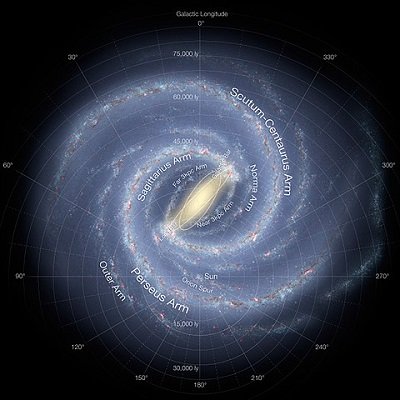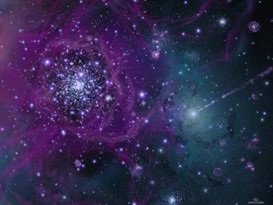The Milky Way
Facts about the Milky way
Barred spiral galaxy
The Milky Way is a barred spiral galaxy.
The center of the galaxy is the nucleus. The stars primarily rotate in a circle
forming disk. The disk looks like a flat narrow band of stars when viewing a spiral galaxy on the
outer edge looking across the galaxy.
Bulge in the center of the galaxy
A bulge in the center of the galaxy contains an unknown number of stars.
As the stars travel around the nucleus of the galaxy, they form spiral arms. Our Solar System is located on one
of the arms of the Milky Way.
The Milky Way

This picture of the Milky Way was drawn by an artist for NASA. The picture shows a bar in the center of the galaxy and the arms that spiral outward from the center of the bar of the galaxy. This image includes the most recent mapping of the central bulge. using ESO's VISTA telescope. NASA
Viewing the Milky Way from earth
Viewing our galaxy
The Milky Way is our home galaxy. You can see
part of the Milky Way on a clear night from Earth. Look for a thick band of
stars stretching across the night sky. Ancient people looking at the heavens
thought the Milky Way was a path to heaven, a stream and even milk.
Location of the Solar System in the Milky Way
Our Solar System sits on the outer edges of one of the
spiral arms of our galaxy. To find out Sun look at the bar in the center of the Galaxy. Look below it and you will see the Sun near the words Orion Spur. Our Solar System is located in a region between two arms called the Orion-Cygnus arm.
Mapping the night sky using 88 constellation
Today astronomers divide the sky into eighty-eight constellations with defined boundaries. Constellations are recognizable patterns that were named long ago after mythological figures.
There are a number of star charts that are free and others that can be purchased on the internet. See how many of these constellations you can see on a clear night.
Edwin Hubble’s discoveries
People believed all the star were in the Milky Way
Prior to 1919 most people believed that all the stars in the
universe were in the Milky Way Galaxy. Edwin Hubble began to study Cepheid
variables, a type of star that pulsates, in nebulae using a large new telescope
at the Mount Wilson Observatory. Nebulae at this time was used to describe any
astronomical areas, including galaxies, that were spread out over a large area.
Inside the nebulae were Cepheid variables he used to determine their distance
from Earth.
Discovering new galaxies
Hubble discovered these stars were not part of the Milky Way
Galaxy. Instead, the nebulae he was studying were separate spiral galaxies beyond
the Milky Way. He published his finding in 1924 in the New York Times and
presented his finding at a meeting of astronomers in 1925. His findings were
not published until 1929 in a scientific journal that fundamentally changed the
way astronomers viewed the universe.
What we know about galaxies
Astronomers have found that galaxies are enormous
collections of stars, gas and dust held together by gravity. The typical galaxy
contains one hundred billion stars and is separated from other galaxies by vast
regions of nearly empty space. Astronomers now estimate that there are more
than one hundred billion major galaxies in the observable universe. Galaxies
range in size from dwarf galaxies with as few as ten million stars to giant
galaxies with over a trillion stars.

It was 1919 when Hubble discovered that the Milky Way was not the only galaxy in the universe. Sputnik 1 to successfully orbit the Earth. Twelve men have walked on the Moon. Mars rovers have discovered new information about the planet. Find out much more about the exploration of space in my book. Every chapter has information, quiz and an activity related to the topic in each chapter. Myrna Martin

Click for More Information and to Order
Major categories of galaxies
Three original categories of galaxies
Hubble originally used three major categories and several minor categories
At one time there were three major groups of galaxies that
was known as the Hubble Sequence. Edwin Hubble classified galaxies into spiral,
elliptical, and irregular.
Today astronomers have added the barred spiral galaxy as a major galaxy because about 50% of spiral galaxies are barred.
Elliptical galaxies
Elliptical galaxies are galaxies with an oval shape. Looking through a telescope they are smooth and featureless. Most of these galaxies contain older stars with a low mass. There is little star formation occurring in elliptical galaxies. The galaxies range in size from tens of millions of stars to over one hundred trillion stars. The age of the stars in elliptical galaxies are generally older than stars found in spiral galaxies.
Spiral galaxies
Spiral galaxies are shaped like a disk with spiral arms
Spiral
galaxies have a central bulge and arms that spiral out and around the nucleus
of the galaxy. The galactic disc contains more gas, dust and young stars than
other parts of the galaxy. These galaxies have a flattened circular volume of
stars that orbit a central core.
The disk is very prominent in most spiral galaxies and is luminous because it contains so many young stars. Young stars move around the central core of the galaxy in small groups because they have recently formed in a nebula. There are up to one hundred young stars in these small groups.
Open clusters of stars
Open
clusters contain between one hundred and one thousand stars. The stars are
bound together by gravitational forces more tightly than the small groups of
stars forming in a nebula.
Central bulge
Surrounding the central bulge is a disk of stars that rotate
around the bulge. The stars separate into arms of the galaxy as they sweep
around the nucleus of the galaxy. Gas, dust and young stars shine brightly in
the arms of the galaxy.
Largest known spiral galaxy at this time
NGC 6872 is the largest known spiral galaxy that has been
found so far. The arms stretch out so far the galaxy is 5 times the size of the
Milky Way. A survey in 1910 using the Hubble Telescope found 72% of the all the
galaxies are spiral galaxies.
Birth of the Milky Way

The picture is an artist’s concept of what the Milky Way looked like 12.7 billion years ago. At this time the arms had not formed. Hundreds of globular clusters of stars came together during the formation of the Milky Way. Astronomers using the Hubble Telescope to find white dwarfs that are the oldest stars to calculate the ages of globular clusters of stars for this picture. NASA/ESA and Adolf Schaller
Milky Way is a barred spiral galaxy
What is a barred spiral galaxy?
The Milky Way is a barred spiral galaxy that is approximately
100,000 light years in diameter. It is estimated that the Milky Way contains two
billion stars.
Barred spiral galaxies are a type of spiral galaxy that has a central bar-shaped structure composed of stars in the central part of the galaxy. About half of all spiral galaxies have a central bar.
Astronomers believe this central structure could have been created when two galaxies collided. The central bar affects the movement of the stars, gases, and the spiral arms.
Central bulge of the milky Way
What the bulge contains
The central bulge is dense and filled with so much dust that
no one can see across our galaxy to the other side. The central bulge cannot be
studied with optical telescopes because dust, gas and stars obstruct its view.
Special telescopes study the bulge
Radio telescopes and X-ray telescopes are used to study the
central bulge of the Milky Way. The central bulge contains the highest density
of stars. It may contain some young stars but most of the population of stars
found in this region are very old. The Galactic Center is a supermassive black
hole that rotates.
Stars in the Milky Way
Stars are large balls of hydrogen and helium with a sprinkling of other elements all in a gaseous form. Gravity pulls matter toward the center of a star as nuclear fusion causes the hydrogen to fuse into helium. The heat from the fusion creates super-heated gases that are forced toward the surface.
A balance forms between the outward and inward pressure of the gases as millions of tons of hydrogen are fused into helium every second. The fusion of hydrogen into helium in the core of a star provides the energy that creates light and other forms of energy in the electromagnetic spectrum.
Our Sun is a dwarf yellow star
Solar System
Our Sun is a yellow dwarf star at the heart of the Solar System. It is a ball of
hot glowing gases that holds the solar system together. The Sun’s gravity holds
everything in the Solar System together from the largest planets to the
smallest dust particles.
Each second the Sun fuses 600 million tons of hydrogen into helium. Four
million tons of matter is converted into energy every second. The Sun’s light
and heat that is being created in the center takes between 10,000 and 170,000
years to escape from its core to produce light and heat that we depend on here
on Earth.
Milky Way's Halo, local group, and globular clusters
Halo of spiral galaxies
The halo of a spiral galaxy is roughly circular in shape and contains
old stars and globular clusters of stars. Ninety percent of these stars are
within 100,000 light years of the Galactic Center. The halo also contains dark
matter that is invisible but can be measured. The halo of the Milky Way is
estimated to be over 130,000 light years across.
The Local Group
The Milky Way and Andromeda Galaxies are part of a local group of spiral
galaxies. There are 50 closely bound giant galaxies in this group. The local
group forms a dumbbell shape. One side of the dumbbell is the Milky Way and its
satellite galaxies and on the other side of the dumbbell is the Andromeda
Galaxy and its satellites.
The two
groups of galaxies are moving toward each. When Hubble first described the
local group it included 12 members. The number of members of the local group
has grown from 12 to 36 by 2003 as newer telescopes studied the local group of galaxies.
Globular Clusters
Globular clusters are compact circular star clusters.
Globular clusters of stars are typically old stars that are in the outer
regions of a galaxy.
KIDS FUN Science Bookstore
Check out Myrna Martin's award winning textbooks, e-books, videos and rock sets. The Kids Fun Science Bookstore covers a wide range of earth science topics. Click here to browse.










